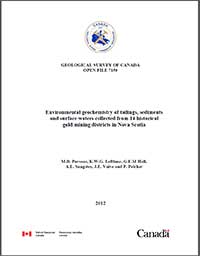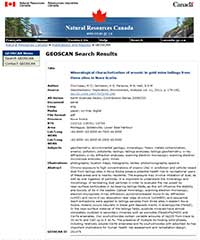
GSC Reports Arsenic
Environmental geochemistry of tailings, sediments and surface waters collected from 14 historical gold mining districts in Nova Scotia

From 1861 to the mid-1940s, stamp milling at orogenic lode gold mines in Nova Scotia generated more than 3,000,000 tonnes of tailings. Most of the mined gold was recovered using mercury (Hg) amalgamation, and an estimated 10-25% of the Hg used was lost to the tailings and to the atmosphere. .
Using soil geochemical data to estimate the range of background element concentrations for ecological and human-health risk assessments

A workshop on the role of geochemical data in ecological and human-health risk assessments was sponsore by Health Canada and Evenironment Canada in 2010. Participants from Geological Survey of Canada developed recommencations for acquiring and analyzing soil geochemical data to support risk assessment and outline a procedure for estimating geochemical background, released as GSC Open File 6645.
Mineralogical characterization of arsenic in gold mine tailings from three sites in Nova Scotia

Chronic exposure to high concentrations of arsenic (As) in windblown and vehicle-raised dust from tailings sites in Nova Scotia poses a potential health risk to recreational users of these areas and to nearby residents. The exposure may involve inhalation of dust, as well as oral ingestion of particles.
Arsenic in Nova Scotia; Goodwin, T A; in, Presentations and recommendations from the workshop on the role of geochemical data in environmental and human health risk assessment, Halifax, 2010

It is recognized that knowledge of geochemistry is an important component of environmental and human health risk assessments. Although much geochemical information needed to better inform risk assessments exists already, these data are not well represented in many of these assessments.